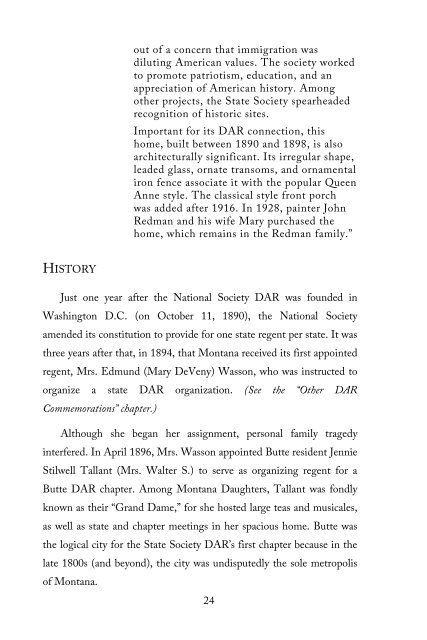Montana's DAR Markers . . . Honoring Where History Was Made
This book is a 200-page thank you to the women of Montana State Society Daughters of the American Revolution for their work in placing historical markers across the state of Montana. Starting in 1908, Montana DAR has installed 70 historical markers across the state. Of those, 33 remain. This book records why the markers’ sites were selected, their history, and the backstory of each.
This book is a 200-page thank you to the women of Montana State Society Daughters of the American Revolution for their work in placing historical markers across the state of Montana. Starting in 1908, Montana DAR has installed 70 historical markers across the state. Of those, 33 remain. This book records why the markers’ sites were selected, their history, and the backstory of each.
Create successful ePaper yourself
Turn your PDF publications into a flip-book with our unique Google optimized e-Paper software.
out of a concern that immigration was<br />
diluting American values. The society worked<br />
to promote patriotism, education, and an<br />
appreciation of American history. Among<br />
other projects, the State Society spearheaded<br />
recognition of historic sites.<br />
Important for its <strong>DAR</strong> connection, this<br />
home, built between 1890 and 1898, is also<br />
architecturally significant. Its irregular shape,<br />
leaded glass, ornate transoms, and ornamental<br />
iron fence associate it with the popular Queen<br />
Anne style. The classical style front porch<br />
was added after 1916. In 1928, painter John<br />
Redman and his wife Mary purchased the<br />
home, which remains in the Redman family.”<br />
HISTORY<br />
Just one year after the National Society <strong>DAR</strong> was founded in<br />
<strong>Was</strong>hington D.C. (on October 11, 1890), the National Society<br />
amended its constitution to provide for one state regent per state. It was<br />
three years after that, in 1894, that Montana received its first appointed<br />
regent, Mrs. Edmund (Mary DeVeny) <strong>Was</strong>son, who was instructed to<br />
organize a state <strong>DAR</strong> organization. (See the “Other <strong>DAR</strong><br />
Commemorations” chapter.)<br />
Although she began her assignment, personal family tragedy<br />
interfered. In April 1896, Mrs. <strong>Was</strong>son appointed Butte resident Jennie<br />
Stilwell Tallant (Mrs. Walter S.) to serve as organizing regent for a<br />
Butte <strong>DAR</strong> chapter. Among Montana Daughters, Tallant was fondly<br />
known as their “Grand Dame,” for she hosted large teas and musicales,<br />
as well as state and chapter meetings in her spacious home. Butte was<br />
the logical city for the State Society <strong>DAR</strong>’s first chapter because in the<br />
late 1800s (and beyond), the city was undisputedly the sole metropolis<br />
of Montana.<br />
24





